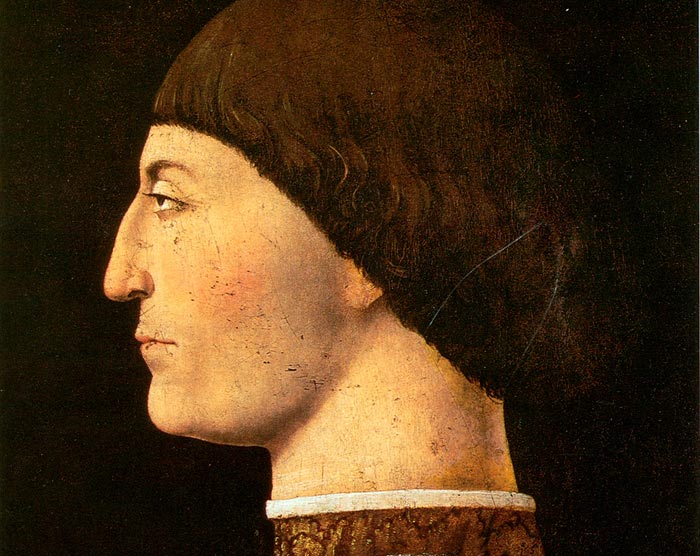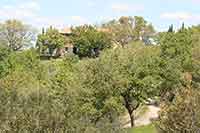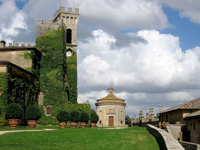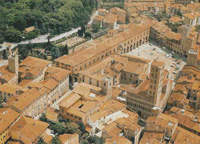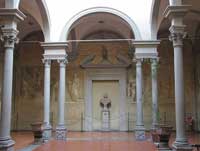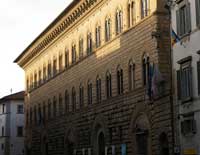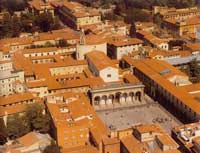| |
|
Piero della Francesca, known in his day as Piero di Benedetto de’ Franceschi, was born in about 1412 in Sansepolcro (or Borgo San Sepolcro, as Sansepolcro was then called), into a merchant family that traded in leather and wool. His artistic gifts enabled him to produce precise and conceptually sophisticated drawings to illustrate Greek and his own texts. He was participated in the intellectual and artistic life of all the principal surrounding courts, Ferrara, Rimini and Urbino, as well as the papal court at Rome.
Vasari reports that Piero also created other works in San Ciriaco (Ancona). Piero thus stayed in le Marche on several occasions, independently of his commitments in Urbino. This accounts for his profound impact on the area’s local painting.
Piero then moved to Ferrara where he found a stimulating environment at the Court which was a model of humanist culture. He met the humanist Guarino da Verona and was allowed to study the gems and coins collected by Duke Lionello At that time there was a painting by Rogier Van der Weyden in Ferrara. This allowed Piero to observe the great Flemish artist’s eye for detail and his command of oil painting. In 1451, Piero left Ferrara for Rimini, which was under the rule of the Malatesta and where he was commissioned to paint the votive fresco of Sigismondo Pandolfo Malatesta in Tempio Malatestiano. In Rimini, Piero took part in the humanist restoration of the Tempio conceived by Leon Battista Alberti, who, besides leaving important architectural masterpieces in Florence, deeply affected the Courts of Mantua and Urbino.
|
|
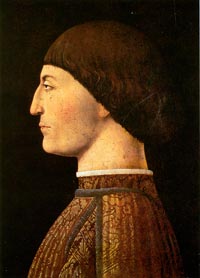
Piero della Francesca, Portrait of Sigismondo Pandolfo Malatesta (c. 1451), Museo del Louvre, Parigi
|
This portrait of Sigismondo Malatesta, Lord of Rimini (1417-1468) is based on the official image of the prince as found on the Pisanello medals of 1445. [1] It is interesting to compare this painting with Piero's 1451 fresco of Sigismondo Pandolfo Malatesta Praying in front of St. Sigismund in the Tempio Malatesta in Rimini, showing the condottiere in profile, kneeling before the Burgundian king Sigismund, his patron saint. It has been conjectured, although there is no actual evidence, that this portrait was a preliminary to the larger composition.
Sigismondo Malatesta (1417-1468), Lord of Rimini, was a condottiere and captain of the church and waspopularly known as the Wolf of Rimini. He was a nobleman, a member of the House of Malatesta and lord of Rimini, Fano, and Cesena from 1432. He was widely considered by his contemporaries as one of the most daring military leaders in Italy and commanded the Venetian forces in the 1465 campaign against the Ottoman Empire. His pride in his military successes drew the jealousy of Pope Pius II, who excommunicated him in 1460, and his subsequent struggles with the papacy earned this protector of the arts a reputation for cruelty and paganism.
He was also a poet and patron of the arts.
|
|

Sigismondo Pandolfo Malatesta, affresco (particolare), Tempio Malatestiano, Rimini
|
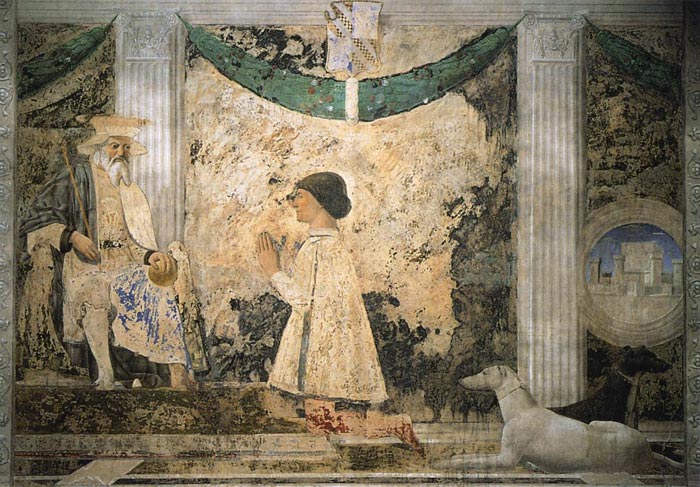
|
Piero della Francesca, Sigismondo Pandolfo Malatesta in preghiera davanti a san Sigismondo, 1451, affresco, Tempio Malatestiano, Rimini
|
| |
Sigismondo grew up in a cultivated family with links to the humanist court of Ferrara: there the House of Este gave him his first wife, Ginevra (1419-1440). Summoning the greatest artists of the period, he turned Rimini into a major Renaissance center: Alberti (1404-1472) designed the facade of the church of San Francesco in Rimini, where the Malatestas were buried and whose paganistic interior earned it the nickname Tempio Malatestiano ("the Malatesta temple"). It was in this church, in 1451, that Piero della Francesca painted a fresco showing Sigismondo in profile, kneeling before his patron saint [1]. The similarities between the fresco and the Louvre portrait suggest that the latter was painted before 1451 and used as a model for the mural.
In 1906, Edward Hutton published the historical novel Sigismondo Malatesta, mostly sympathetic to its hero. It was slightly revised and reprinted under the title The Mastiff of Rimini in 1926. Hutton's novel and Charles Emile Yriarte's Un condottiere au XV Siècle (1882) were among the main sources of American poet Ezra Pound's Malatesta Cantos (Cantos 8-11), first published in 1923. These are an admiring howbeit fragmentary account of Malatesta's career as warrior, lover and patron.
Largely influenced by Pound, as well as by C. G. Jung, the critic Adrian Stokes devoted a study, The Stones of Rimini (1934), to the art created at Sigismondo's court. |
|
|
|
| |
|

Art in Tuscany | Giorgio Vasari's Lives of the Artists | Piero della Francesca

|
[1] Sigismondo Malatesta was not a religious man, and his Tempio Malatestiano, also known as San Francesco, built in Rimini, by Leon Battista Alberti and decorated by artists including Piero della Francesca and Agostino di Duccio, was essentially a lay monument to Isotta degli Atti, his lover and third wife. It was a landmark Renaissance building, being the first church to use the Roman triumphal arch as part of its structure. Sigismondo also built a notable series of fortifications in his Romagna possessions, including the Rocche ("Castles") of Rimini and Fano.
Sigismondo Pandolfo Malatesta
"This head and shoulders profile of a richly dressed subject is an example of the court portrait, much esteemed in the art circles of northern Italy when the "International Gothic" was in full flower. It draws on the images for coins that came in the wake of humanist interest in Classical antiquity. Unlike the delicately worked faces produced by Pisanello, however, this one stands out in vigorous relief from its dark background. When in Florence in 1439, Piero was doubtless marked by painterly experiments in the representation of space and volume. Thus, in contrast with Pisanello's Portrait of a Princess of the House of Este in the Louvre, the subject's shoulder, shown in full profile, seems foreshortened in terms of standard visual perspective. The play of light gives a powerfully modeled, column-like neck. The artist tends to geometrize the forms, as in the way the line of the hair hews to the diagonal of the picture, dividing the composition in two. (...)
Analysis of the paint has shown that in some places Piero had added oil to the egg that was the standard binder at the time. Only the greater suppleness of oil allowed him to achieve the perfection of skin tone we find here: subtlety of contour, transparency - the skin beneath the bluish shading of the shaven cheek - and the precision of such touches as the thread of light beneath the chin. It was this Flemish-inspired use of the medium that allowed Piero to create here what seems to be a living portrait."
Cécile Maisonneuve, Dominique Thiébaut, Sigismondo Pandolfo Malesta by Piero della FRANCESCA, Paintings | Louvre Museum
|
|
|
![]()

